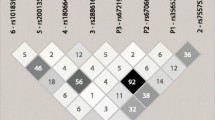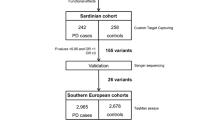Abstract
This work presents a detailed investigation of the genomic region surrounding the PRNP gene in a sample of patients diagnosed with fatal familial insomnia (FFI) from several European countries, notably Spain. The main focus of the study was to explore the origins of the chromosomes carrying the D178N mutation by designing a single-nucleotide polymorphism (SNP) haplotype around the PRNP gene. Haplotypes were constructed by genotyping six SNPs (rs2756271, rs13040327, rs6037932, rs13045348, rs6116474, and rs6116475) in 25 FFI patients from all over Spain. To augment the geographical scope of our study, 13 further FFI cases from Germany (9) and Italy (4) were also examined. Genotyping of SNPs in conjunction with the analysis of genealogical data for a group of FFI patients revealed the existence of two distinct haplotypes potentially associated with the D178N mutation. Of them, GCATTA-M proved to be the common haplotype of Spanish patients, whereas ACATTA-M was typical of the German cases. It is interesting to note that both haplotypes were identified in the Italian samples: GCATTA-M in a family from the Tuscany region and ACATTA-M in a family from the Veneto region. Our findings suggest the occurrence of two independent D178N-129M mutational events in Europe, preserved and transmitted from one generation to the next until nowadays. Likewise, results based on the analysis of SNP data indicate that previous hypotheses postulating that the D178N mutation had independent origins for each family and that its global distribution was determined by recurrent mutational events must be regarded with caution.



Similar content being viewed by others

References
Medori R, Tritschler HJ, LeBlanc A, Villare F, Manetto V, Chen HY, Xue R, Leal S, Montagna P, Cortelli P (1992) Fatal familial insomnia, a prion disease with a mutation at codon 178 of the prion protein gene. N Engl J Med 326:444–449
Goldfarb LG, Petersen RB, Tabaton M, Brown P, LeBlanc AC, Montagna P, Cortelli P, Julien J, Vital C, Pendelbury WW (1992) Fatal familial insomnia and familial Creutzfeldt–Jakob disease: disease phenotype determined by a DNA polymorphism. Science 258:806–808
Parchi P, Petersen RB, Chen SG, Autilio-Gambetti L, Capellari S, Monari L, Cortelli P, Montagna P, Lugaresi E, Gambetti P (1998) Molecular pathology of fatal familial insomnia. Brain Pathol 8:539–548
Zarranz JJ, Digon A, Atares B, Rodriguez-Martinez AB, Arce A, Carrera N, Fernandez-Manchola I, Fernandez-Martinez M, Fernandez-Maiztegui C, Forcadas I, Galdos L, Gomez-Esteban JC, Ibanez A, Lezcano E, Lopez dM, Marti-Masso JF, Mendibe MM, Urtasun M, Uterga JM, Saracibar N, Velasco F, de Pancorbo MM (2005) Phenotypic variability in familial prion diseases due to the D178N mutation. J Neurol Neurosurg Psychiatry 76:1491–1496
Zerr I, Giese A, Windl O, Kropp S, Schulz-Schaeffer W, Riedemann C, Skworc K, Bodemer M, Kretzschmar HA, Poser S (1998) Phenotypic variability in fatal familial insomnia (D178N-129M) genotype. Neurology 51:1398–1405
Goldfarb LG (2006) Genotype–phenotype relationships: fatal familial insomnia and Creutzfeldt–Jakob disease. Encyclopedia of Life Sciences, DOI 10.1038/npg.els.0006037
Gambetti P, Parchi P, Petersen RB, Chen SG, Lugaresi E (1995) Fatal familial insomnia and familial Creutzfeldt–Jakob disease: clinical, pathological and molecular features. Brain Pathol 5:43–51
Montagna P, Cortelli P, Avoni P, Tinuper P, Plazzi G, Gallassi R, Portaluppi F, Julien J, Vital C, Delisle MB, Gambetti P, Lugaresi E (1998) Clinical features of fatal familial insomnia: phenotypic variability in relation to a polymorphism at codon 129 of the prion protein gene. Brain Pathol 8:515–520
Johnson MD, Vnencak-Jones CL, McLean MJ (1998) Fatal familial insomnia: clinical and pathologic heterogeneity in genetic half brothers. Neurology 51:1715–1717
McLean CA, Storey E, Gardner RJ, Tannenberg AE, Cervenakova L, Brown P (1997) The D178N (cis-129M) “fatal familial insomnia” mutation associated with diverse clinicopathologic phenotypes in an Australian kindred. Neurology 49:552–558
Taniwaki Y, Hara H, Doh-Ura K, Murakami I, Tashiro H, Yamasaki T, Shigeto H, Arakawa K, Araki E, Yamada T, Iwaki T, Kira J (2000) Familial Creutzfeldt–Jakob disease with D178N-129M mutation of PRNP presenting as cerebellar ataxia without insomnia. J Neurol Neurosurg Psychiatry 68:388
Kovacs GG, Puopolo M, Ladogana A, Pocchiari M, Budka H, van Duijn C, Collins SJ, Boyd A, Giulivi A, Coulthart M, Delasnerie-Laupretre N, Brandel JP, Zerr I, Kretzschmar HA, Pedro-Cuesta J, Calero-Lara M, Glatzel M, Aguzzi A, Bishop M, Knight R, Belay G, Will R, Mitrova E (2005) Genetic prion disease: the EUROCJD experience. Hum Genet 118:166–174
Pocchiari M, Ladogana A, Petraroli R, Cardone F, D’Alessandro M (1998) Recent Italian FFI cases. Brain Pathol 8:564–566
Heinemann U, Krasnianski A, Meissner B, Varges D, Kallenberg K, Schulz-Schaeffer WJ, Steinhoff BJ, Grasbon-Frodl EM, Kretzschmar HA, Zerr I (2007) Creutzfeldt–Jakob disease in Germany: a prospective 12-year surveillance. Brain 130:1350–1359
Rodriguez-Martinez AB, Barreau C, Coupry I, Yague J, Sanchez-Valle R, Galdos-Alcelay L, Ibanez A, Digon A, Fernandez-Manchola I, Goizet C, Castro A, Cuevas N, Alvarez-Alvarez M, de Pancorbo MM, Arveiler B, Zarranz JJ (2005) Ancestral origins of the prion protein gene D178N mutation in the Basque Country. Hum Genet 117:61–69
Lee HS, Sambuughin N, Cervenakova L, Chapman J, Pocchiari M, Litvak S, Qi HY, Budka H, del Ser T, Furukawa H, Brown P, Gajdusek DC, Long JC, Korczyn AD, Goldfarb LG (1999) Ancestral origins and worldwide distribution of the PRNP 200K mutation causing familial Creutzfeldt–Jakob disease. Am J Hum Genet 64:1063–1070
Dagvadorj A, Petersen RB, Lee HS, Cervenakova L, Shatunov A, Budka H, Brown P, Gambetti P, Goldfarb LG (2002) Spontaneous mutations in the prion protein gene causing transmissible spongiform encephalopathy. Ann Neurol 52:355–359
Ramakrishnan U, Mountain JL (2004) Precision and accuracy of divergence time estimates from STR and SNPSTR variation. Mol Biol Evol 21:1960–1971
Campbell C, Mitui M, Eng L, Coutinho G, Thorstenson Y, Gatti RA (2003) ATM mutations on distinct SNP and STR haplotypes in ataxia–telangiectasia patients of differing ethnicities reveal ancestral founder effects. Human Mutat 21:80–85
Sharma D, Gupta M, Thelma BK (2003) FMR1 haplotype analyses among Indians: a weak founder effect and other findings. Hum Genet 112:262–271
Manica A, Prugnolle F, Balloux F (2005) Geography is a better determinant of human genetic differentiation than ethnicity. Hum Genet 118:366–371
Tishkoff SA, Pakstis AJ, Ruano G, Kidd KK (2000) The accuracy of statistical methods for estimation of haplotype frequencies: an example from the CD4 locus. Am J Hum Genet 67:518–522
Tishkoff SA, Pakstis AJ, Stoneking M, Kidd JR, Destro-Bisol G, Sanjantila A, Lu RB, Deinard AS, Sirugo G, Jenkins T, Kidd KK, Clark AG (2000) Short tandem-repeat polymorphism/alu haplotype variation at the PLAT locus: implications for modern human origins. Am J Hum Genet 67:901–925
Rademakers R, Baker M, Gass J, Adamson J, Huey ED, Momeni P, Spina S, Coppola G, Karydas AM, Stewart H, Johnson N, Hsiung GY, Kelley B, Kuntz K, Steinbart E, Wood EM, Yu CE, Josephs K, Sorenson E, Womack KB, Weintraub S, Pickering-Brown SM, Schofield PR, Brooks WS, Van Deerlin VM, Snowden J, Clark CM, Kertesz A, Boylan K, Ghetti B, Neary D, Schellenberg GD, Beach TG, Mesulam M, Mann D, Grafman J, Mackenzie IR, Feldman H, Bird T, Petersen R, Knopman D, Boeve B, Geschwind DH, Miller B, Wszolek Z, Lippa C, Bigio EH, Dickson D, Graff-Radford N, Hutton M (2007) Phenotypic variability associated with progranulin haploinsufficiency in patients with the common 1477C→T (Arg493X) mutation: an international initiative. Lancet Neurol 6:857–868
Scholefield J, Greenberg J (2007) A common SNP haplotype provides molecular proof of a founder effect of Huntington disease linking two South African populations. Eur J Hum Genet 15:590–595
Tsujikawa K, Tsujikawa M, Watanabe H, Maeda N, Inoue Y, Fujikado T, Tano Y (2007) Allelic homogeneity in Avellino corneal dystrophy due to a founder effect. J Hum Genet 52:92–97
Preuss S, Peischl T, Melchinger E, Geldermann H (2004) Numerous polymorphic microsatellites in the human prion gene complex (including PRNP, PRND and PRNT). Gene 329:197–203
McCormack JE, Baybutt HN, Everington D, Will RG, Ironside JW, Manson JC (2002) PRNP contains both intronic and upstream regulatory regions that may influence susceptibility to Creutzfeldt–Jakob Disease. Gene 288:139–146
Mead S, Mahal SP, Beck J, Campbell T, Farrall M, Fisher E, Collinge J (2001) Sporadic—but not variant—Creutzfeldt–Jakob disease is associated with polymorphisms upstream of PRNP exon 1. Am J Hum Genet 69:1225–1235
Guo SW, Thompson EA (1992) Performing the exact test of Hardy–Weinberg proportion for multiple alleles. Biometrics 48:361–372
Excoffier L, Laval G, Schneider S (2005) Arlequin ver. 3. 0: an integrated software package for population genetics data analysis. Evolutionary Bioinformatics Online 1:47–50
Whitfield LS, Sulston JE, Goodfellow PN (1995) Sequence variation of the human Y chromosome. Nature 378:379–380
Nachman MW, Crowell SL (2000) Estimate of the mutation rate per nucleotide in humans. Genetics 156:297–304
Miyakawa T, Inoue K, Iseki E, Kawanishi C, Sugiyama N, Onishi H, Yamada Y, Suzuki K, Iwabuchi K, Kosaka K (1998) Japanese Creutzfeldt–Jakob disease patients exhibiting high incidence of the E200K PRNP mutation and located in the basin of a river. Neurol Res 20:684–688
Colombo R (2000) Age and origin of the PRNP E200K mutation causing familial Creutzfeldt–Jacob disease in Libyan Jews. Am J Hum Genet 67:528–531
Ellegren H (2000) Heterogeneous mutation processes in human microsatellite DNA sequences. Nat Genet 24:400–402
Chakraborty R, Kimmel M, Stivers DN, Davison LJ, Deka R (1997) Relative mutation rates at di-, tri-, and tetranucleotide microsatellite loci. Proc Natl Acad Sci USA 94:1041–1046
Zhivotovsky LA (2001) Estimating divergence time with the use of microsatellite genetic distances: impacts of population growth and gene flow. Mol Biol Evol 18:700–709
Zhivotovsky LA, Rosenberg NA, Feldman MW (2003) Features of evolution and expansion of modern humans, inferred from genomewide microsatellite markers. Am J Hum Genet 72:1171–1186
Stoneking M (2001) Single nucleotide polymorphisms. From the evolutionary past.... Nature 409:821–822
Acknowledgments
The authors are grateful to Prof. P Montagna, P Cortelli, and Dr. P Avoni for providing the clinical data on the Italian case I-02. This study was funded by Research Projects EET-2002/05165 from Ministerio de Educación y Ciencia (Spain), GIU 05/51 from Universidad del País Vasco (UPV/EHU, Spain), and FIS 05/0912 from Fondo de Investigaciones Sanitarias (Spain). AB Rodríguez-Martínez was supported by a doctoral fellowship from the Basque Government (BFI02.1).
Author information
Authors and Affiliations
Corresponding author
Electronic supplementary material
Below is the link to the electronic supplementary material.
Table S1
Age of onset, sex, duration of illness, and clinical features of 38 European FFI cases (DOC 169 kb)
Rights and permissions
About this article
Cite this article
Rodríguez-Martínez, A.B., Alfonso-Sánchez, M.A., Peña, J.A. et al. Molecular evidence of founder effects of fatal familial insomnia through SNP haplotypes around the D178N mutation. Neurogenetics 9, 109–118 (2008). https://doi.org/10.1007/s10048-008-0120-x
Received:
Accepted:
Published:
Issue Date:
DOI: https://doi.org/10.1007/s10048-008-0120-x



